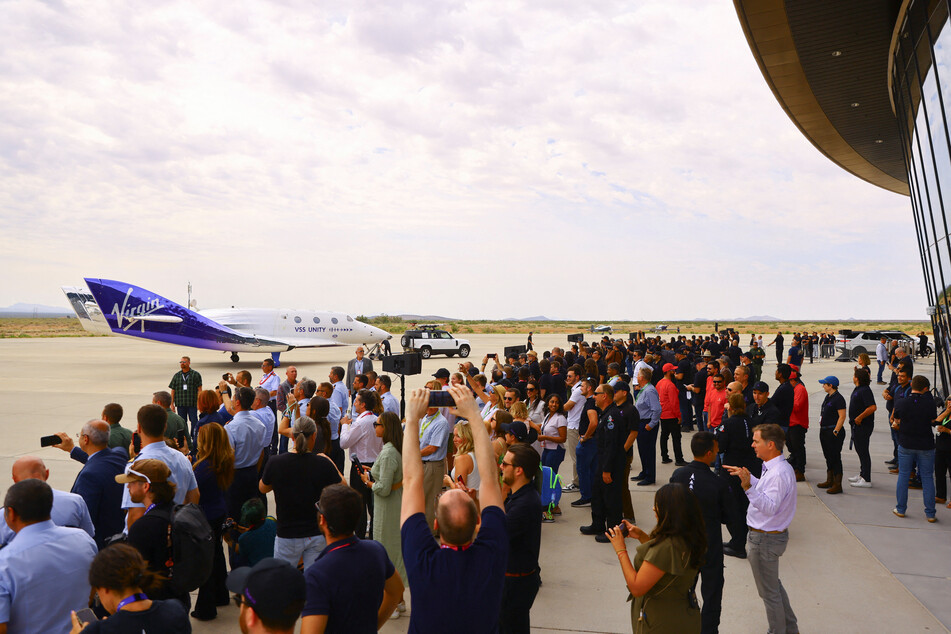Virgin Galactic finally takes its first paying customers to space!
Truth and Consequences, New Mexico - For a ticket price of close to half a million dollars, Virgin Galactic is now taking private individuals roughly 54 miles into space to experience the feeling of weightlessness.

For years, British billionaire Richard Branson vowed that commercial space flights with his firm Virgin Galactic were just around the corner.
On Thursday, that hype finally became reality when three Italian researchers boarded the VSS Unity space plane as Virgin Galactic's first paying passengers and flew about four minutes in suborbital space.
The researchers – Col. Walter Villadei and Lt. Col. Angelo Landolfi of the Italian Air Force and Pantaleone Carlucci, an engineer with the National Research Council of Italy – spent their precious minutes in microgravity conducting scientific research.
The carrier aircraft and the attached VSS Unity space plane took off from the Spaceport America launch site around 7:30 AM PT near Truth and Consequences, New Mexico, and climbed to an altitude of about 45,000 feet.
By 8:30 AM, the carrier aircraft released the space plane, which rocketed to the edge of space.
At 8:31 AM, the space plane's motor cut off, and the researchers were free to move around. Villadei was the only researcher to get out of his seat, and he propelled himself to the back of the craft where he tended to experiments on a stationary rack.
By 8:35 AM, everyone was back in their seats. The craft touched down back in New Mexico around 8:44 AM.
Prior to Thursday's flight, only Branson and Virgin Galactic employees had flown aboard the space plane. As of last year, the company had received reservations for nearly 800 tickets and collected $103.3 million in deposits and membership fees from "future astronauts," according to Virgin Galactic's most recent annual report.
A seat on Virgin Galactic's space plane now costs $450,000, up from the initial price of $200,000 that early enthusiasts paid.
Virgin Galactic's journey extends chatter on adventure tourism in wake of OceanGate sub implosion

Thursday's mission high above the New Mexico desert showcased a part of the space tourism market not often discussed — research flights.
While space tourism is more commonly associated with wealthy passengers achieving lifelong dreams of spaceflight, companies like Virgin Galactic and Jeff Bezos' Blue Origin have also touted suborbital spaceflight as an opportunity for scientists to conduct their experiments in a microgravity environment.
Performing experiments in orbital space isn't really an option, with the cost and time needed to prepare for intensive spaceflight likely outweighing the benefits. Scientists can also send their experiments to the International Space Station, but they can't tend to them themselves.
Virgin Galactic Chief Executive Michael Colglazier nodded to the company's dual revenue streams in a statement released before the flight, noting that the company's "two dynamic products" are scientific research and private astronaut flights.
However, the flight also comes as extreme or adventure tourism is increasingly scrutinized after the implosion of the OceanGate deep-sea exploration submersible, which killed all five passengers aboard.
A disaster on the scale of the OceanGate submersible implosion has not happened in the commercial spaceflight industry. But there have been mishaps.
Nearly two years ago, Virgin Galactic's spacecraft went off course during Branson's flight to suborbital space. After an FAA investigation into the matter, the company was cleared to return to flight.
In 2014, an earlier version of Virgin Galactic's spacecraft broke apart in midair during a powered test flight, killing the co-pilot and injuring the pilot.
Cover photo: IMAGO / USA TODAY Network
